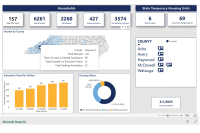New Haywood warning system a collaborative effort

Emergencies like the Gatlinburg fires of 2016 and simulated emergencies like last week’s Operation Vigilant Catamount in Canton have brought disaster planning back to the forefront of many minds locally — perfect timing for Haywood County Emergency Services Coordinator Greg Shuping to make his pitch for a new emergency notification system.
“What could be more important than the fundamental job of notifying our citizens that an emergency is, or is about to, occur?” Shuping said. “What could be more important?”
Last year’s wildfires were an eye-opener for the similarly situated Haywood County, a tinderbox of unmolested forests with an aging population strewn across narrow mountain roads ridges and dead-end streets.
“We looked at that situation and we said, ‘What if a major fire occurred in our county? How can we get folks the opportunity to evacuate safety?’ When we saw our plan we felt like it needed to be revised,” he said.
A committee was formed months ago, consisting of all local municipalities and the county, and one area of concern was the existing mechanisms by which governments communicate with their citizens.
“Disseminating crisis information takes a plethora of options to reach the end user, the person that really needs the message,” said Shuping.
Related Items
Maggie Valley, Waynesville and Clyde use an automated telephone and email notification system called Code Red; Canton uses something called Blackboard and the county uses Rapid Notify.
“We were one of the first counties in the state to have a system,” Shuping said. “Back in 2002, the mill [Evergreen Packaging] offered to purchase a system, but the county found a grant when Homeland Security money was first coming in wake of 9-11.”
The county used a portion of its funding to purchase the system, which Shuping said has served the county well, but is showing its age.
“It is extremely limited, and it really only wants to call landline phones. It has an interface for folks to opt in with cell phones, but it is very difficult and time-consuming and so nobody does it.”
Just 15 years after implementing the then state-of-the-art system, the shrinking attention span of smartphone-addled Americans places new importance on the ease of opting in to it.
“In this society — and I’m part of that society — I’m not going to spend 10 minutes to sign up for anything,” Shuping said. “If they were going to give me $50, I might think about it.”
And “they” are not giving anyone $50 to opt in to potentially life-saving emergency notifications.
“We’ve got to convince you why, on a beautiful day in downtown Waynesville, why you would take even a moment of your time to sign up for something that you probably don’t even believe will happen,” Shuping said.
As Shuping’s committee shopped vendors — including the existing Code Red system — it found helpful information both near and far.
“We looked at what the counties around us were using, and many of the counties around here recently hired a vendor,” he said. “We were so early in the game that we just hadn’t considered it lately. So we looked regionally and we found out that there was quite a few Code Red counties in the far west.”
Conversely, larger counties east of Haywood — like Buncombe and Henderson — were using a company called Everbridge.
“It kind of opened our eyes little bit,” he said. “Then we did a little bit more research. We looked at counties and cities that were nationally accredited emergency management systems, which is very hard to get.”
No city or county in North Carolina except Guilford County is a nationally accredited emergency management system, and Shuping thinks there are only around 50 or so in the entire country.
“About eight of them don’t use Everbridge,” he said. “The top performers in the emergency management world are using this tool.”
After fielding proposals from both Code Red and Everbridge, the committee made a decision based largely on the ease of signing in to the application.
“Literally I can say ‘Text your zip code to 888–777’ and you’re in,” he said. “It’s like American Idol. Everybody votes on American Idol.”
Shuping’s goal is for a full 40 percent of county residents to sign up after the system’s been live for a year. It’s been approved by Waynesvile, Maggie Valley and Canton and will be presented to the Town of Clyde June 21.
After that, it will be presented to the Haywood County Board of County Commissioners for final approval July 17 and be phased in over the coming months.
As municipalities transition into the system, citizens will find a mix of old and new functionality that takes advantage of advances in location-based smartphone technology.
“Let’s say a fire occurred at the Apple Festival. You’re already opted in for emergency notifications if you operate a landline at your home or your business. The businesses would get the alert because they have a phone, and the people in the ZIP Code would get the alert because that’s the ZIP code they’ve opted into,” Shuping said. “We can use this tool to create a polygon or perimeter around that fire and call everyone within that perimeter.”
The additional capability of keyword creation will allow the county to further inform people with event-specific alerts — even tourists who wouldn’t otherwise opt in to a Haywood County emergency system.
For example, the keywords ‘Apple Festival 2017’ could be used to notify attendees of road closures, full parking lots or even situational emergencies.
“If there’s a missing kid during this festival, we want all 10,000 people at the Apple Festival to be searchers,” he said.
Visitors can also find out about the availability of keywords as they’re searching the internet for information on the numerous festivals, fairs and rallies popular in the county.
“Anytime you use Google to search for anything that in any way, shape or form may trigger that keyword, at the top of the Google search engine page, it’s going to come up and say ‘Click here to receive alerts for the festival.’”
Users opting in by keywords will not be opted into the system as a whole, so as not to burden travelers with emergency notifications that don’t apply to them.
“It’s meant to be a temporary interface between us and attendees for that particular subject matter,” Shuping said. “We don’t want to create keywords every day because it would dilute the importance of the message.”
To avoid confusing or conflicting alerts, a strict chain of command will be followed beginning with the incident commander on scene and progressing up through the county.
While the ease and efficacy of the new system will help keep Haywood County safer and more alert, municipalities also like the cost. A one-year contract with Everbridge is currently on the table, and includes rates locked in at $16,870 for the next three years.
With a service population of 59,036 people, that works out to about 29 cents per resident, per year.
The cost will be shared among the municipalities on a pro-rated basis according to population, and in most cases costs just half of current technology — but only because of the collaborative nature of the effort, without which it would have cost twice as much.
“Because of our collaboration and willingness to collaborate — and you know that is not easy, we’re all busy — we built this plan together,” said Shuping.









